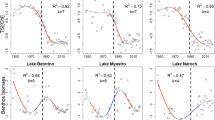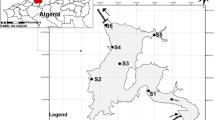Abstract
Macrozoobenthos and submerged macrophytes interact closely. However, studies in China have focused on the middle and lower reaches of the Yangtze River, where shallow lakes are concentrated, rather than on temperate lakes. To clarify the responses of taxonomic and functional groups of macrozoobenthos in temperate lakes to changes in submerged macrophyte biomass (BMac) on a large scale, 19 temperate lakes within Baiyangdian Lake were investigated in this study. The BMac differed greatly across the 19 lakes, and Potamogeton crispus was the dominant species. According to the BMac, the 19 lakes were divided into 4 groups. One-way analysis of variance and Pearson correlation analysis showed that the water environmental parameters were different among the 4 groups, and the BMac was significant correlated with all the physical and chemical parameters of water bodies (except for water depth). Forty-one taxa of macrozoobenthos were identified in the 19 lakes, with oligochaetes, Hirudinea, gastropods, crustaceans, chironomid larvae, and aquatic insects (excluding chironomid larvae) represented by 9, 1, 4, 2, 19, and 6 species, respectively. Chironomid larvae and oligochaetes dominated by density, and gastropods and chironomid larvae dominated by biomass. Canonical correspondence analysis showed that the BMac was the most important factor affecting the macrozoobenthos community structure in group 1 to group 4. Macrozoobenthos with low pollution tolerance values were mainly found in areas with high BMac, while species with high pollution tolerance values were mainly distributed in areas with low BMac and high nutrient contents. Different taxonomic and functional groups of macrozoobenthos responded differently to changes in BMac. As BMac increased, density and biomass of oligochaetes and chironomid larvae tended to decrease, while those of gastropods and aquatic insects tended to first decrease and then increase. Collectors had more species than any other functional group in group 1 to group 4. As BMac increased, density and biomass of collectors gradually decreased, while density of predators, shredders, and scrapers tended to first decrease and then increase.







Similar content being viewed by others
References
Blindow I (1992) Long- and short-term dynamics of submerged macrophytes in two shallow eutrophic lakes. Freshw Biol 28:15–27. https://doi.org/10.1111/j.1365-2427.1992.tb00558.x
Chambers PA, Lacoul P, Murphy KJ, Thomaz SM (2008) Global diversity of aquatic macrophytes in freshwater. Hydrobiologia 595:9–26. https://doi.org/10.1007/s10750-007-9154-6
Chen L, Zhang Y, Liu Q, Hu Z, Chen L (2015) Spatial variations of macrozoobenthos and sediment nutrients in Lake Yangcheng: emphasis on effect of pen culture of Chinese mitten crab. J Environ Sci 37:118–129. https://doi.org/10.1016/j.jes.2015.06.008
Diao XJ, Huang CH, He LS, Meng R, Yuan DH (2013) Difference in community structure of submerged macrophytes and related influence factors between macrophytic and algal regions of Baiyangdian lake. Wetl Sci 11:366–371
Gong Z, Xie P, Wang S (2000) Macrozoobenthos in 2 shallow, mesotrophic Chinese Lakes with contrasting sources of primary production. J N Am Benthol Soc 19:709–724. https://doi.org/10.2307/1468128
Hansen JP, Wikström SA, Axemar H, Kautsky L (2011) Distribution differences and active habitat choices of invertebrates between macrophytes of different morphological complexity. Aquat Ecol 45:11–22. https://doi.org/10.1007/s10452-010-9319-7
Hilt S, Brothers S, Jeppesen E, Veraart AJ, Kosten S (2017) Translating regime shifts in shallow lakes into changes in ecosystem functions and services. BioScience 67:928–936. https://doi.org/10.1093/biosci/bix106
Jeppesen E, Sondergaard M, Sondergaard M, Christoffersen KE (1998) The structuring role of submerged macrophytes in lakes. Springer – Verlag, New York
Jiang PH, Liang XM, Chen F, Zhou YY, Wang HZ (2006) Indication of macrophyte-restorable area by spatial pattern of macrobenthos in Yuehu Lake. Resour Environ Yangtze Basin 15:502–505
Jones JI, Sayer CD (2003) Does the fish–invertebrate–periphyton cascade precipitate plant loss in shallow lakes? Ecology 84:2155–2167. https://doi.org/10.1890/02-0422
Koller-Peroutka M, Lendl T, Watzka M, Adlassnig W (2015) Capture of algae promotes growth and propagation in aquatic Utricularia. Ann Bot 115:227–236. https://doi.org/10.1093/aob/mcu236
Li W, Cheng Y (1999) Quantitative analysis on the main submerged communities in Honghu Lake. 1. Potamogeton maackianus community. Acta Hydrobiol Sin 23:53–58
Li KY, Liu ZW, Hu YH, Yang HW (2009) Snail herbivory on submerged macrophytes and nutrient release: implications for macrophyte management. Ecol Eng 35:1664–1667. https://doi.org/10.1016/j.ecoleng.2008.05.009
Liang YL, Wang HZ (1999) Zoobenhos. In: Liu JK (ed) Advanced Hydrobiology. Science Press, Beijing, pp 241–259
Liang Y, Wu T, Xie Z (1995) On the current conditions of zoobenthos in Baoan Lake with an assessment of its potential fishery production capacity. In: Liang YL, Liu HQ (eds) Resources, Environment and Fishery Ecological Management of Macrophytic Lakes. Science Press, Beijing
Liu X, Chen K, Chen Q, Wang M, Wang L (2016) The community structure of macroinvertebrate and its relationship to the environmental factors in summer and autumn within typical reaches of Huai River Basin. Acta Sci Circumst 36:1928–1938. https://doi.org/10.13671/j.hjkxxb.2015.0575
Mandaville SM (2002) Benthic macroinvertebrates in freshwaters-taxa tolerance values, metrics, and protocols. Soil and Water Conservation Society of Metro Halifax, Nova Scotia
Ministry of Ecology and Environment of China (2020) Technical guidelines for monitoring and evaluating aquatic ecological of the lakes and the reservoirs (draft for comments). Ministry of Ecology and Environment of China, Beijing
Newman RM (1991) Herbivory and detritivory on freshwater macrophytes by invertebrates: a review. J N Am Benthol Soc 10:89–114. https://doi.org/10.2307/1467571
Ni LY (1999) Aquatic macrophytes. In: Liu JK (ed) Advanced Hydrobiology. Science Press, Beijing, pp 224–240
Pan B, Wang H, Wang H, Wang Z (2011) Macrozoobenthic assemblages in relation to environments of the Yangtze-isolated Lakes. Front Environ Sci Eng 6:246–254. https://doi.org/10.1007/s11783-011-0381-8
Pan BZ, Wang HJ, Liang XM, Wang HZ (2012) Macrozoobenthos in Yangtze floodplain lakes: patterns of density, biomass, and production in relation to river connectivity. J N Am Benthol Soc 30:589–602. https://doi.org/10.1899/10-025.1
Qin S, Cui JS, Ju ZJ, Shen LN, Zhang LL, Fu Y (2021) Changes of benthic invertebrate community in the Baiyangdian Lake and analysis of main environmental factors under the condition of human disturbance. Acta Sci Circumst 41:1123–1133
Scheffer M (1998) Ecology of shallow lakes. Kluwer Academic Publishers, London
Scheffer M, Jeppesen E (2007) Regime shifts in shallow lakes. Ecosystems 10:1–3. https://doi.org/10.1007/s10021-006-9002-y
Tan SY, Li Z, Cheng S (2017) Ecological interaction between submerged macrophytes and zoobenthos. SDRP J Earth Sci Environ Stud 2:1–10. https://doi.org/10.25177/jeses.2.2.2
Underwood GJC, Thomas JD, Baker JH (1992) An experimental investigation of interactions in snail-macrophyte-epiphyte systems. Oecologia 91:587–595. https://doi.org/10.1007/bf00650335
Van den Berg MS, Scheffer M, Van Nes E, Coops H (1999) Dynamics and stability of Chara sp. and Potamogeton pectinatus in a shallow lake changing in eutrophication level. Hydrobiologia 408:335–342. https://doi.org/10.1023/A:1017074211970
Wang HJ (2007) Predictive limnological studies on small to medium sized lakes along the mid-lower Yangtze River. [doctoral dissertation]. Institute of Hydrobiology, Chinese Academy of Sciences, Wuhan
Wang SM, Dou HS (1998) Lakes of China. Science Press, Beijing
Wang HJ, Pan BZ, Liang XM, Wang HZ (2006) Gastropods on submersed macrophytes in Yangtze Lakes: community characteristics and empirical modelling. Int Rev Hydrobiol 91:521–538. https://doi.org/10.1002/iroh.200510846
Wang J, Song Y, Wang G (2016) Causes of large Potamogeton crispus L. population increase in Xuanwu Lake. Environ Sci Pollut Res 24:5144–5151. https://doi.org/10.1007/s11356-016-6514-7
Wang HZ, Wang HJ, Liang XM, Ni LY, Liu XQ, Cui YD (2005) Empirical modelling of submersed macrophytes in Yangtze Lakes. Ecol Model 188:483–491. https://doi.org/10.1016/j.ecolmodel.2005.02.006
Wang D, Men B, Zhang M (2020) Sediment water ecotone and sediment removal of shallow lake: a case study of Baiyangdian Lake in Xiong’an new area. Acta Sci Circumst 40:1550–1559
Xie S, Huang BS, Wang HW, Song CY, Shi BZ (2010) Assessment of water quality in Baiyangdian Lake by zoobenthos biodiversity. J Hydroecol 3:43–48
Xu M, Zhu J, Huang Y, Gao Y, Wang ZJ (1998) The ecological degradation and restoration of Baiyangdian Lake, China. J Freshw Ecol 13:433–446. https://doi.org/10.1080/02705060.1998.9663640
Yang W, Yan J, Wang Y, Zhang BT, Wang H (2020) Seasonal variation of aquatic macrophytes and its relationship with environmental factors in Baiyangdian Lake, China. Sci Total Environ 708:135112. https://doi.org/10.1016/j.scitotenv.2019.135112
Zhang Y, Jeppesen E, Liu X, Qin B, Shi K, Zhou Y, Thomaz SM, Deng J (2017) Global loss of aquatic vegetation in Lakes. Earth Sci Rev 173:259–265. https://doi.org/10.1016/j.earscirev.2017.08.013
Zhang Y, Cheng L, Tolonen KE, Yin H, Gao J, Zhang Z, Li K, Cai Y (2018) Substrate degradation and nutrient enrichment structuring macroinvertebrate assemblages in agriculturally dominated Lake Chaohu Basins, China. Sci Total Environ 627:57–66. https://doi.org/10.1016/j.scitotenv.2018.01.232
Zhang XK, Liu X, Yang ZD, Wang HZ (2019) Restoration of aquatic plants after extreme flooding and drought: a case study from Poyang Lake National nature reserve. Appl Ecol. Environ Res 17:15657–15668. https://doi.org/10.15666/aeer/1706_1565715668
Zhang X, Zhang J, Li Z, Wang G, Xie J (2021) Optimal submerged macrophyte coverage for improving water quality in a temperate lake in China. Ecol Eng 162:106177. https://doi.org/10.1016/j.ecoleng.2021.106177
Acknowledgements
We would like to thank Heyin Wang and Xiao Wang of Anqing Normal University for their help in the field survey.
Funding
This study was supported by the National Key R&D Program of China (2019YFD0900604), the Shanghai Sailing Program (No. 18YF1407500), and the Baiyangdian Aquatic Biological Resources Investigation and Water Ecological Restoration Demonstration Project (2018 LKY007).
Author information
Authors and Affiliations
Contributions
Hao Zhu and Xiaoke Zhang designed the study and performed the experiments. Hao Zhu and Xuan Che performed the experiments. Hao Zhu, Shuiping Cheng, and Xiaoke Zhang prepared the figures and tables. Xiaoke Zhang, Shuiping Cheng, and Xingguo Liu analysed the data, and Hao Zhu wrote the manuscript.
Corresponding author
Ethics declarations
Ethics approval and consent to participate
Not applicable.
Consent for publication
Not applicable.
Competing interests
The authors declare no competing interests.
Additional information
Responsible Editor: Thomas Hein
Publisher’s note
Springer Nature remains neutral with regard to jurisdictional claims in published maps and institutional affiliations.
Appendix 1
Appendix 1
Rights and permissions
About this article
Cite this article
Zhu, H., Cheng, S., Zhang, X. et al. Responses of macrozoobenthos communities to changes in submerged macrophyte biomass in 19 temperate lakes in China. Environ Sci Pollut Res 29, 59211–59223 (2022). https://doi.org/10.1007/s11356-022-20007-5
Received:
Accepted:
Published:
Issue Date:
DOI: https://doi.org/10.1007/s11356-022-20007-5




